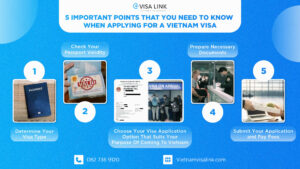The Vietnam visa application process can seem daunting, but with the right knowledge, it becomes much simpler. Whether you’re traveling for business or pleasure, understanding the essential steps is key to securing your visa without unnecessary stress. From choosing the correct visa type to ensuring your documentation is in order, each step plays a critical role.
At Vietnam Visa Link, we believe that your journey begins long before you board your flight. It starts the moment you decide to explore this captivating country. That’s why we’ve listed 5 crucial points to help you through the process and ensure your trip to Vietnam starts smoothly.
1. Determine Your Visa Type
This is the first crucial step in your trip. Vietnam offers several visa options, for example:
- Tourist Visa: For those planning to explore Vietnam’s wonders
- Business Visa: For individuals traveling for work-related purposes
- Student Visa: For those pursuing education in Vietnam
- Work Visa: For foreigners employed in Vietnam
Each visa type has specific requirements and durations. Ensure you choose the one that best fits your travel purpose to avoid any complications during your stay.
2. Check Your Passport Validity
This is a detail that many travelers overlook, but it’s absolutely crucial. Vietnam, like many other countries, requires that your passport be valid for at least 6 months beyond your planned stay. This requirement is strictly enforced, and failing to meet it can result in denied entry, even if you’ve already obtained a visa. Before you begin your visa application, take a moment to check your passport’s expiration date. If it’s cutting it close, consider renewing your passport before applying for your Vietnam visa.
3. Choose Your Visa Application Option That Suits Your Purpose Of Coming To Vietnam
Vietnam primarily offers two ways to obtain a visa: Visa on Arrival (VOA) and E-Visa. The VOA requires a pre-approval letter obtained online, with the actual visa being stamped upon arrival at select Vietnamese airports. While convenient for air travelers, it’s not applicable for land or sea entry. On the other hand, the E-Visa involves a fully online application process and is suitable for short stays of up to 3 months. It can be used for air, land, and sea entry at specific checkpoints. Your choice between these methods will depend on your travel plans, entry point, and length of stay.
4. Prepare Necessary Documents
While the exact requirements may vary based on your chosen visa type and application method, common documents include:
- Passport image
- Your photo
- The airport you will land at Vietnam
- All the stamps at Vietnam immigration custom gates (if you have visited Vietnam before)
- The accommodation address in Vietnam (optional)
For business or work visas, additional documents like invitation letters or work permits may be required. Always check the latest requirements on official Vietnamese government websites or consult with us at Vietnam Visa Link for the most up-to-date information.
5. Submit Your Application and Pay Fees
If you’ve opted for an e-visa, you’ll complete this process online. For visa on arrival, you’ll need to apply for your pre-approval letter through a reputable agency. Don’t forget about the visa fees, which can vary depending on your visa type and duration of stay. These typically include a non-refundable visa application fee and, for visa on arrival, a visa stamping fee. It’s important to note that fees are subject to change, so always check for the most current information.
By focusing on these 5 key points, you’ll be well-prepared to navigate the Vietnam visa application process. At Vietnam Visa Link, we’re here to assist you every step of the way, ensuring your journey to Vietnam starts on the right foot. Remember, a little preparation goes a long way in ensuring a smooth and hassle-free entry into the beautiful country of Vietnam. Happy travels!


